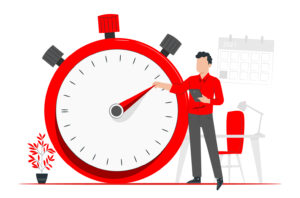Maximizing productivity without compromising quality is a crucial aspect for many businesses, as it gives them a significant competitive advantage. For this reason, many companies focus on workforce management technology, hybrid work models, artificial intelligence, while placing workplace productivity issues somewhat in the background.
Of course, understanding the factors that drive productivity in the modern business world is not easy for employers. Technology plays the most decisive role here. The work environment, on the other hand, either supports or hinders creativity and collaboration. Additionally, employee engagement is critically important. Research shows that engaged employees tend to increase productivity, and companies with the highest engagement are 21% more profitable and 17% more efficient. Conversely, another study found that low employee engagement negatively impacts performance and is a global issue. The estimated annual cost of disengaged employees to the U.S. economy is nearly $450-550 billion.
If these statistics and data have caught your attention, let’s dive deeper. In this blog post, we thoroughly explore topics such as employee engagement, the role of technology, and the impact of work environments, all supported by statistics that highlight their influence on business performance.

Productivity Trends and Statistics: Take Your Business to the Next Level
In the business world, statistics help companies understand their current state and see clearly the factors that impact their performance. This is true not only for large enterprises but for businesses of all sizes. Productivity has become more important than ever as processes accelerate and competition intensifies.
Workplace Productivity Trends and Insights
For many companies, maximizing productivity while maintaining quality provides a significant advantage. That’s why businesses are turning to workforce management tools, hybrid work models, and AI technologies to boost productivity. Making decisions based on productivity data not only saves time but also helps employees reach their full potential more effectively.
Understanding the factors affecting productivity in the modern workplace can be more complex than it seems. Technology plays a critical role here, offering tools that boost productivity, reduce waste, and streamline workflows. But technology alone isn’t enough—the work environment itself can either encourage or hinder collaboration and creativity. Providing the right environment is just as important as having the right tech.
Employee Engagement and Productivity
Employee engagement is also directly linked to productivity. In workplaces with high engagement levels, employees are more motivated and productive. Studies show that companies with the most engaged employees are not only 21% more profitable but also 17% more productive. This highlights the real impact of a workplace that listens to its employees and meets their needs.
On the flip side, disengaged employees can lead to significant financial losses. The U.S. economy, for example, suffers an estimated annual loss of $450-550 billion due to disengaged workers. So, this isn’t just a human resources issue—it’s a major economic one.
The Impact of Technology and Workplace Environment
Technological advancements and workplace environments have an undeniable effect on employee engagement and productivity. Businesses can enhance satisfaction and efficiency by optimizing these two areas during their digital transformation journeys. Hybrid work models and flexible hours contribute significantly to work-life balance, helping employees feel more connected to their work.
Workforce Productivity: Key Insights and Trends
The U.S. Bureau of Labor Statistics (BLS) provides essential insights into workforce productivity across various industries. Analyzing this data helps businesses understand the trends and factors that impact productivity. Here are some key findings:
- Productivity in the non-farm business sector increased by 0.3% in the first quarter of 2024.
- Hourly wages rose by 5% during the same period.
- Unit labor costs went up by 4.7%.
- Real value-added production grew by 1.3%.
- Hours worked increased by 1%.
These numbers show that productivity saw a slight improvement despite rising labor costs. The increase in hourly wages suggests that companies are willing to offer better pay to attract and retain talented employees. It also highlights that businesses are more eager to invest in their workforce to boost engagement and overall productivity.
Key Factors That Drive Workplace Productivity
Improving productivity at work requires a combination of different elements. Everything from the tools employees use to the work environment plays a role in boosting productivity.
Technology and Innovation
We’re at a point where it’s impossible to do business without technology. New tools and software help speed up processes, automate repetitive tasks, and make communication between teams smoother. Companies that embrace these innovations not only improve productivity but also allow their employees to focus on more creative and meaningful work.
For instance, a study from 2014 on Allied Bank Ltd. in Pakistan showed that adopting new technologies helped employees complete their tasks faster, which improved performance. This not only boosted productivity but also made the work experience more satisfying, leading to increased employee engagement. Today, the effects are even more significant.
Work Culture and Employee Engagement
A strong work culture is essential for a productive workplace. When employees feel valued and supported, they are more motivated and engaged in their work. This increases productivity and reduces workplace stress. Teams that feel trusted and appreciated tend to work more efficiently.
Gallup’s research shows that highly engaged teams are 14% more productive compared to those with lower engagement levels. A culture that prioritizes employee engagement also helps reduce turnover—employees who feel aligned with the company’s values are less likely to leave, which saves on the costs associated with turnover.
Organizational Structure and Management Style
Employees work best when there’s a clear hierarchy and well-defined roles, as these provide a sense of purpose and direction. Supportive management practices, like open communication and flexibility, play a big part in employees’ decisions to stay with a company. Creating an environment where employees feel they can grow leads to increased productivity.
It’s also crucial to regularly evaluate these management practices and adapt them based on feedback. This helps meet the changing needs of the workforce, building a motivated and efficient team that drives organizational success.
How to Succeed?
Boosting productivity at work means investing in technology, building a positive work culture, and prioritizing employee engagement. Technology can automate repetitive tasks, freeing up employees to focus on creative and strategic projects. At the same time, creating a supportive environment where employees feel valued boosts both productivity and job satisfaction.
By using these elements intentionally, your business can stay competitive and achieve sustainable success. Investing in your employees and creating a strong company culture can take productivity to the next level. After all, happy employees are the foundation of a successful business.
Visit our website for more insights and discover the best solutions to boost your team’s productivity



